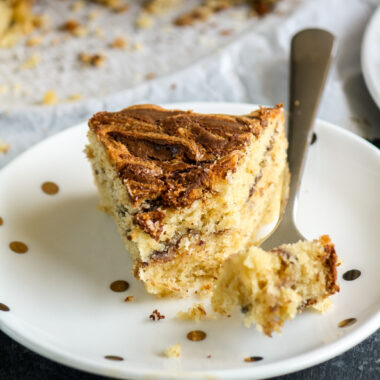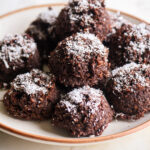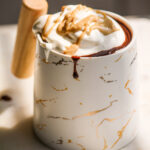It took me five tries to get this cake right and every time I thought “ok this is madness, I have to stop”, I’d go back into the kitchen with one more possible way to tinker with it and make it work. I always knew creating an eggless version of this dense chocolate loaf wouldn’t be a cakewalk (sorry) but I have to admit, I thought it would be a quicker process! I’m so happy to report though that in the end, there’s no compromise in flavour or texture and I hope you love this!
 This kind of cake is a little different because the proportion of moisture to flour is a bit higher. With hot water, eggs, lots of butter, some milk and some yoghurt, that’s how the original one gets it’s unique soft, slightly fudgy, super moist texture. In a version without eggs, there’s suddenly nothing to give the batter structure and my first attempt collapsed spectacularly. From the second to the fourth, I figured out how to adjust the proportion a bit, using more yoghurt as an egg substitute, less butter (without the eggs, the fat in the butter doesn’t emulsify and the original amount was too much and it just leaked out and made a greasy mess), a little cornflour for extra binding, and when I finally got the flavour and texture right, I still found I was dealing with a sunken center and slices that just wouldn’t hold together which was heartbreaking!
This kind of cake is a little different because the proportion of moisture to flour is a bit higher. With hot water, eggs, lots of butter, some milk and some yoghurt, that’s how the original one gets it’s unique soft, slightly fudgy, super moist texture. In a version without eggs, there’s suddenly nothing to give the batter structure and my first attempt collapsed spectacularly. From the second to the fourth, I figured out how to adjust the proportion a bit, using more yoghurt as an egg substitute, less butter (without the eggs, the fat in the butter doesn’t emulsify and the original amount was too much and it just leaked out and made a greasy mess), a little cornflour for extra binding, and when I finally got the flavour and texture right, I still found I was dealing with a sunken center and slices that just wouldn’t hold together which was heartbreaking!
The culprit was too much baking soda in the absence of the natural structure that eggs provided. So though the batter needs help to rise, the baking soda caused it to rise too much and then fall as it cooled because there wasn’t enough solid structure to hold it up. So I reduced the baking soda, and then instead of insisting on baking it as a loaf, I baked it as a round cake and that did the trick. The batter has more room to spread, rises more evenly and some natural cracks on top aren’t enough to destroy the center or leave you with broken slices. Hooray!! While the loaf cake photos show a cake made with the larger amount of baking soda and the round one has lesser, I still don’t recommend using this recipe in a loaf tin because the chances of it rising a little unevenly still exist. A round tin is just safer!
For convenience, resist the temptation to cut this cake when it’s even slightly warm. Preferably, leave it to cool overnight at room temperature, or refrigerate for 30 minutes before you cut it. Because of everything I said above, this is a fragile cake and it’s worth being patient so you can really enjoy every moist, chocolatey bite!
It is unbelievably soft and is THE thing when chocolate cravings hit. I hope you enjoy this as much as I did!
Please read the recipe notes before beginning.

Eggless Dense Chocolate Cake
Ingredients
- 85 gms dark chocolate (70% to 75%), finely chopped (see notes)
- 85 gms butter at room temperature
- 3/4th cup soft brown sugar (150 gms, see notes)
- 3 tbsps thick plain yoghurt or curd, at room temperature
- 2 tbsps milk, at room temperature
- 1 tsp vanilla extract
- 3/4th cup all-purpose flour (90 gms)
- 1 tbsp cocoa powder
- 1 tbsp cornflour/cornstarch
- 1/4 tsp baking soda
- Pinch of salt if using unsalted butter
- 1/4 cup freshly boiled water (60 ml)
Instructions
- Preheat the oven to 170 C. Grease an 8 inch round cake tin, or line it with non-stick baking paper. See notes for more on different cake tin sizes.
- Melt the chocolate in the microwave in 10 second increments, stirring in between. Or you could use a double boiler method as well. Either way, don't over-heat the chocolate, if some lumps remain stir until they're melted through. Set aside.
- In a mixing bowl, beat the butter and sugar with a hand mixer on low speed until pale and creamy. Add the yoghurt, milk, vanilla and beat slowly to combine. The yoghurt could cause a grainy appearance, don't worry.
- Now pour in the melted chocolate and stir gently by hand to combine, using a silicone spatula preferably. Do not over-mix.
- Sift in the flour, cocoa, cornflour, baking soda and salt. Stir briefly, then bit by bit, pour in the hot water, using the spatula to fold the batter as you go. The batter should be smooth, but be gentle while mixing.
- Pour into the prepared tin, smoothen the top and bake for 30 to 35 minutes until a toothpick poked in the center comes out clean or with a few moist crumbs. Let the cake cool in the tin COMPLETELY and preferably overnight at room temperature. While there shouldn't be a majorly sunken center (over mixing the batter can lead to this) the center might fall very slightly as the cake cools, this is ok.
- This cake is on the fragile side and will have some cracks on top as it bakes. Therefore use a sharp knife to slice it and if you're concerned, place it in the fridge for 30 minutes before cutting to guarantee neat slices.
- Store at room temperature in an airtight tin for 3 to 4 days or in the fridge for about 10 days. Bring to room temperature before eating. It can also be frozen for longer. Happy baking!
Notes
Shop this recipe!
This post contains affiliate links.


















Pingback: Chocolate Strawberry Cupcakes
Pingback: Chocolate Peanut Butter Cake
If baking in a 6″ x 4″ loaf tin , how much of baking soda will you add? Will the measurements of all other ingredients given above change or will that be the same?
If you see the post and recipe notes, a loaf tin creates a more fragile cake prone to breaking. You can however try this same batter in a loaf tin with no changes to any ingredients as I’ve used less baking soda in the final recipe compared to my trials.
Pingback: Rich Chocolate Cake with Cream Cheese Frosting
Pingback: Boozy Cherry Chocolate Cakes
Pingback: Dense Chocolate Loaf